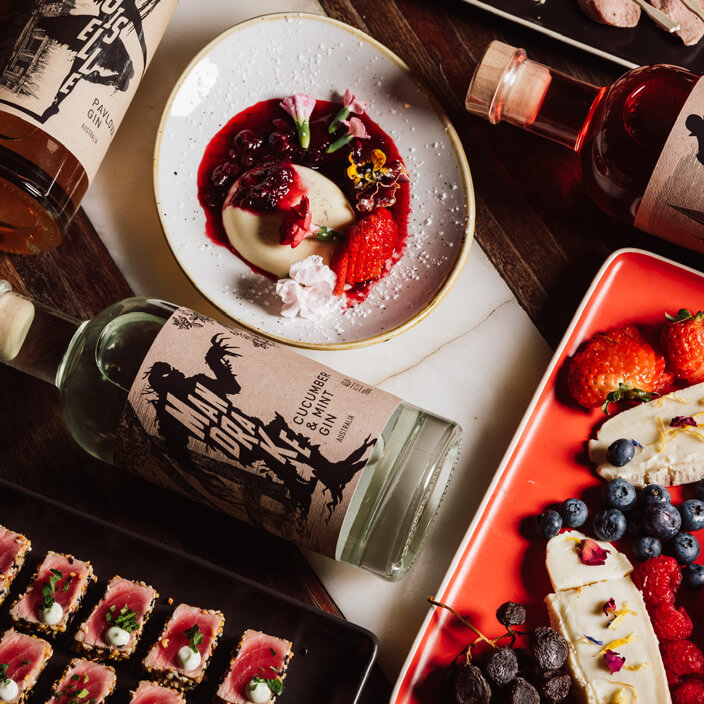It all started when Rory Smith, a boy with a gift for all things creative, grew up to study film and have a career in commercial production. However, after it occurred to him that he wasn’t going to hit the big time in Hollywood, Rory came to the realisation that he was meant for other things.
And so, born out of a love of gin and stemming from a keen interest in the arts, Nosferatu Distillery opened in 2018 with a delightfully noir range of spirits – each accompanied by ingredients, distillation techniques, and stories that are as fascinating as they are mysterious.
Head distiller, Ashley Mellor, said Rory has always loved the movie Nosferatu – also known as the best vampire movie ever made.
“It’s a silent, black-and-white movie released in 1922 and an unauthorised and unofficial adaptation of Bram Stoker’s 1897 novel, Dracula. The film stars Maximilian Schreck as Count Orlok.
“Bram Stoker’s heirs sued over the adaptation, and a court ruling ordered all copies of the film to be destroyed. However, several prints of Nosferatu survived, and the film came to be regarded as an influential masterpiece of cinema and the horror genre.
“As our first and signature gin is the Blood Orange Gin, our name just made sense! The spirit has gone on to win many awards and hearts while amassing quite a cult following,” she said.
Fortunately for us, after opening in Melbourne, the Nosferatu Distillery was moved to Brisbane’s Bowen Hills in 2022. In Queensland, Rory set out to demonstrate that food pairings (which are a celebrated and normal concept in the wine industry) can be applicable with gins as well.
As such, the brand’s core range is designed with food pairings in mind and encourages customers to have their own ‘Ginner Party’ by coupling spirits with complementary dishes.
Despite the distillery’s many points of difference, Ashley said they take a mostly traditional approach to the creation of their gins.
“We use carefully selected gin botanicals with the end flavour profile in mind and thoughtfully pick which stage in the distillation process to use the botanical to influence the end flavour.
“Mouthfeel is also really important to us, so we use a three-stage citrus infusion process to give our gins a great texture. Gin is a great product to experiment with, as the only rule is that it needs to contain juniper as the dominant botanical.
“We reverse-engineer our spirits and select flavours that not only pair well with food, but also stand up well by themselves. We make sure to painstakingly test our ideas until we have nailed them,” she said.
Indeed, every single one of Nosferatu Distillery’s core range made it into the Ginuary Festival’s Hottest 100 Aussie Gins of 2023, which only continues the pattern of Queensland craft distillers finding immense success in today’s industry.
The brand gained notoriety pretty early in its existence as well, with the vibrant, spicy, rich, smooth, and viscous Nosferatu Blood Orange Gin winning Best Gin Bottle in Australia at the Australian Gin Awards in 2018.
Ashley said Rory has always loved Pimm’s and Campari, so he wanted their first gin to have elements of this.
“Our signature spirit uses toasted fenugreek as a botanical. As far as we know, it’s the only gin that does this! The botanical is used in Pimm’s and provides a hint of bitterness at the end in addition to a nutty flavour.
“We toast the fenugreek just like James Pimm did in 1823. This caramelises it and converts the starches into sugars, giving it a lovely toffee and roasted caramel taste.
“Nosferatu Blood Orange Gin has more backbone and savoury qualities, so it pairs well with stronger flavoured foods such duck, other game birds, and even roast lamb and black peppercorns,” she said.
It’s no doubt that Rory’s love of film, gothic literature, and the arts has also been an incredibly important part of the brand’s success. Each gin is represented by a mythological character and comes with a glimpse into their cultural history, making each sip an experience rather than just another drink.
Ashley said their Mandrake Cucumber and Mint Gin, for example, continues their obsession with old books and spooky folklore.
“Mandrakes were mentioned in legend, the Bible, and Shakespeare’s Romeo and Juliet. More recently, mandrakes appeared in J.K. Rowling’s Harry Potter books and films, where fully grown mandrake roots scream when pulled from the ground, killing anyone unfortunate enough to hear their cries.
“This gin has flavours of cucumber, mint, lemon, citrus, and liquorice root and is best served with seafood and lighter dishes. It works well alongside saline and fresh flavour profiles – think granita on raw oysters with finger lime or tuna crudo,” she said.
On the other hand, Nosferatu’s Giselle Pavlova Gin is designed to taste like a pavlova base without the fruit on top. Achieved by macerating the ingredients post-distillation, the spirit tastes like cream, vanilla, toffee, and burnt meringue.
Ashley said Anna Pavlova was a Russian ballerina who danced the famous Giselle Ballet almost to her death.
“Giselle is one of the most renowned ballets and is often performed around the world. It’s the story of a peasant girl who dies of a broken heart after being tricked by her wealthy and powerful lover. But just like our gin, revenge is best served cold and sweet, and Giselle returns as a beautiful ghost.
“Of course, most people would think to pair this with a traditional pavlova. However, as these flavours are already present, it’s far more fun to put them next to fresh fruit tarts and bright, tropical flavours. The sweetness of the gin cries out for some fresh acidity,” she said.
The last bottle in the distillery’s core range is the fruity and slightly sweet Bunyip Sticky Gin, which is especially unique due to being blended with unfermented grape juice, making it a modern interpretation of the French classic called Mistelle.
Ashley said they loved experimenting with Muscat and Pino Grigio grapes for their gin version of a sticky wine.
“Deep in the Aussie bush lives the elusive man-eating bunyip. Despite many attempts, no one has ever captured one. Rumour has it that it was sighted where we got our first batch of grapes from on the Mornington Peninsula.
“A bunyip is a creature from Indigenous mythology that lives in rivers and creeks. For this one, we hoped to create something new and unusual, so that’s exactly what we did.
“This ‘cheese course’ gin can be enjoyed at the start of a meal or at the end, depending on where you would usually eat cheese. Generally, the funkier the cheese, the fruitier the gin becomes, whereas saltier cheese makes the gin sweeter,” she said.
Rounding out Nosferatu Distillery’s range is their Dead Dry Gin, Dead Dry Vodka, Rye + Corn Whiskey, and Death + Taxes Dry Gin – a limited edition collaboration with the Death & Taxes bar group.
In addition to a coffin-shaped pot still named Schreck, Nosferatu Distillery boasts a picturesque café and bar set inside a romantic, industrial shed surrounded by beautiful hanging garden beds, reclaimed wine barrels, and fairy lights.
Ashley said their venue is a fantastic function space akin to a gin garden party, with their drinks being served out of a vintage caravan.
“Here, customers can sample all of our products on a tasting paddle, try some bespoke cocktails featuring our spirits, or buy our bottles and gift packs. The best part is that all of our gin distilling equipment is on display, so patrons can watch the distiller work while they have a coffee or a cheeky drink.
“We’d love to increase our focus on food pairings, as we think this is what sets our range apart from other distilleries. We have just opened up a kitchen, so we can now offer more substantial meals to pair with our gins.
“We will also be releasing a coffee liqueur very soon, and in a few months, be sure to look out for a fig gin! In the meantime, hotels, pubs, and bars can buy our range from wholesalers such as Bouchon Wines and Spirits, Paramount Liquor, and Australian Liquor Marketers (ALM).
It’s pretty easy to get excited about Nosferatu Distillery when you can hear from the passionate people behind the brand while immersing yourself in the curious myths and gothic tales that have never ceased to captivate, terrify, and inspire us.
Ashley said if they have learnt anything, it’s that customers love to uncover the stories that drive their distillery.
“Most imported brands lack a backstory and are mass produced, so making our gins in small batches allows us to produce more interesting, greater quality gins locally. Consumers love local products, whether they’re Australian-made or, even better, Queensland-made.
“We made a strong choice not to be a ‘location name’ distillery. We want to be loved everywhere, not just in our local area. It’s also better for the environment to buy locally, rather than have products shipped all the way from overseas.
“We have a strong desire to lower our carbon footprint and make products that can be created and served with this in mind while using traditional gin botanicals to create solid, delicious, and unique gins,” she said.

